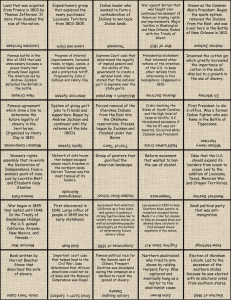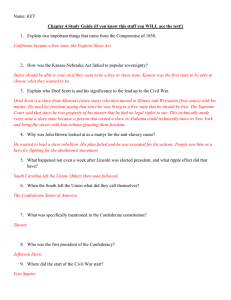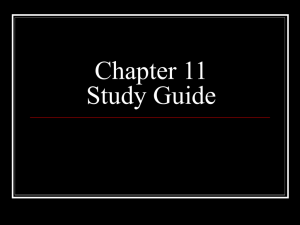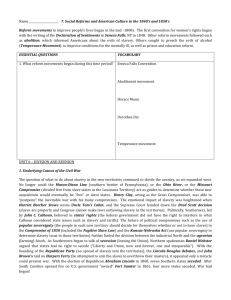Sectionalism & Civil War - West Ada School District
advertisement
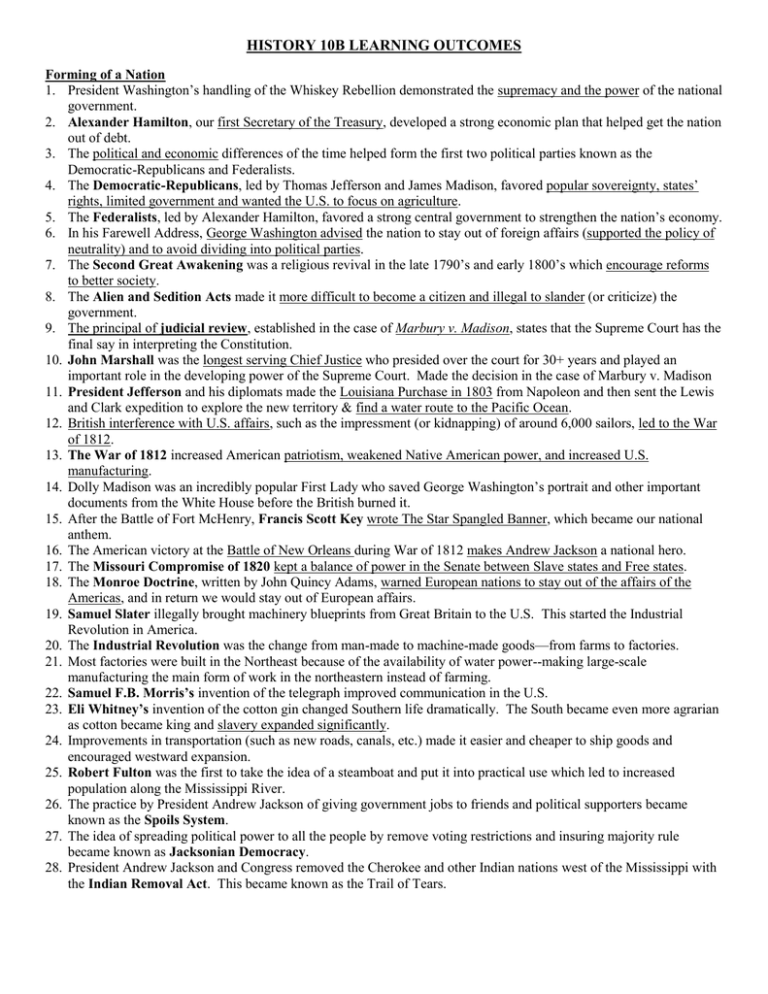
HISTORY 10B LEARNING OUTCOMES Forming of a Nation 1. President Washington’s handling of the Whiskey Rebellion demonstrated the supremacy and the power of the national government. 2. Alexander Hamilton, our first Secretary of the Treasury, developed a strong economic plan that helped get the nation out of debt. 3. The political and economic differences of the time helped form the first two political parties known as the Democratic-Republicans and Federalists. 4. The Democratic-Republicans, led by Thomas Jefferson and James Madison, favored popular sovereignty, states’ rights, limited government and wanted the U.S. to focus on agriculture. 5. The Federalists, led by Alexander Hamilton, favored a strong central government to strengthen the nation’s economy. 6. In his Farewell Address, George Washington advised the nation to stay out of foreign affairs (supported the policy of neutrality) and to avoid dividing into political parties. 7. The Second Great Awakening was a religious revival in the late 1790’s and early 1800’s which encourage reforms to better society. 8. The Alien and Sedition Acts made it more difficult to become a citizen and illegal to slander (or criticize) the government. 9. The principal of judicial review, established in the case of Marbury v. Madison, states that the Supreme Court has the final say in interpreting the Constitution. 10. John Marshall was the longest serving Chief Justice who presided over the court for 30+ years and played an important role in the developing power of the Supreme Court. Made the decision in the case of Marbury v. Madison 11. President Jefferson and his diplomats made the Louisiana Purchase in 1803 from Napoleon and then sent the Lewis and Clark expedition to explore the new territory & find a water route to the Pacific Ocean. 12. British interference with U.S. affairs, such as the impressment (or kidnapping) of around 6,000 sailors, led to the War of 1812. 13. The War of 1812 increased American patriotism, weakened Native American power, and increased U.S. manufacturing. 14. Dolly Madison was an incredibly popular First Lady who saved George Washington’s portrait and other important documents from the White House before the British burned it. 15. After the Battle of Fort McHenry, Francis Scott Key wrote The Star Spangled Banner, which became our national anthem. 16. The American victory at the Battle of New Orleans during War of 1812 makes Andrew Jackson a national hero. 17. The Missouri Compromise of 1820 kept a balance of power in the Senate between Slave states and Free states. 18. The Monroe Doctrine, written by John Quincy Adams, warned European nations to stay out of the affairs of the Americas, and in return we would stay out of European affairs. 19. Samuel Slater illegally brought machinery blueprints from Great Britain to the U.S. This started the Industrial Revolution in America. 20. The Industrial Revolution was the change from man-made to machine-made goods—from farms to factories. 21. Most factories were built in the Northeast because of the availability of water power--making large-scale manufacturing the main form of work in the northeastern instead of farming. 22. Samuel F.B. Morris’s invention of the telegraph improved communication in the U.S. 23. Eli Whitney’s invention of the cotton gin changed Southern life dramatically. The South became even more agrarian as cotton became king and slavery expanded significantly. 24. Improvements in transportation (such as new roads, canals, etc.) made it easier and cheaper to ship goods and encouraged westward expansion. 25. Robert Fulton was the first to take the idea of a steamboat and put it into practical use which led to increased population along the Mississippi River. 26. The practice by President Andrew Jackson of giving government jobs to friends and political supporters became known as the Spoils System. 27. The idea of spreading political power to all the people by remove voting restrictions and insuring majority rule became known as Jacksonian Democracy. 28. President Andrew Jackson and Congress removed the Cherokee and other Indian nations west of the Mississippi with the Indian Removal Act. This became known as the Trail of Tears. Manifest Destiny 29. Manifest Destiny was the belief that the United States was to spread its borders from the Atlantic Ocean to the Pacific Ocean. 30. The pioneer push into the West and their demands for land increased tensions between Native Americans and white settlers. 31. Many of the pioneers moved west in search of land, wealth or religious freedom. 32. Mountain men trapping for furs initiated the American movement to the West by opening up trails for the pioneers. The rendezvous—a meeting between the trappers and traders to exchange the pelts for supplies—kept the flow of information about the West to the East. 33. Trails that were created by the Mountain Men, such as the Oregon Trail and the Santa Fe Trail, were used by settlers in the move west. 34. Stephen F. Austin led many American farmers into the Spanish land called Tejas to establish a colony there. 35. Disputes over the Texas border led to a clash between Mexican and American soldiers on the Rio Grande and sparked the Mexican-American War. 36. The Mexican-American War concluded with an American victory. The Treaty of Guadalupe gave the U.S. the huge expanse of western land known as the Mexican Cession. 37. The discovery of gold in 1848 at John Sutter’s mill sparked the California gold rush of 1849 causing an influx of people from diverse ethnic backgrounds. The people that moved to California looking for gold were known as FortyNiners! Sectionalism & Civil War 38. In the 1800’s, sectionalism (loyalty to your own region instead of to the nation) divided the United States into three regions, Northeast, South, and West. 39. The main issues dividing the North and the South were differing views regarding states’ rights and slavery. 40. The newly formed Republican Party was opposed to slavery; formed by former Whigs and Free Soilers. 41. The doctrine of nullification said that a state had the right to nullify, or reject, a federal law that it considered unconstitutional. 42. The Kansas-Nebraska Act used the concept of popular sovereignty (allow the people to vote) to decide the slave issue in these two new states, in effect repealing the Missouri Compromise. It led to the clash between abolitionists and pro-slavery advocates known as “Bleeding Kansas.” 43. The Compromise of 1850 was a series of laws that settled a the major disagreements between the Slave and Free states, it included the Fugitive Slave Act which helped slave owners recapture runaway slaves in Northern states. 44. The debates between Abe Lincoln and Stephen Douglas for a seat in the Senate made Lincoln a nationally-known figure (even though he lost) and are now seen as models for political debate. 45. Abolitionists—such as former slave Frederick Douglass—wrote papers, spoke publicly, and demonstrated against slavery. 46. Harriet Tubman was an escaped slave who became the most famous conductor on the Underground Railroad--an above ground series of escape routes from the South to the North and Canada traveled on by runaway slaves. 47. Elizabeth Cady Stanton and Lucretia Mott organized the Seneca Falls Convention in New York in 1848. It was the first major meeting to promote women’s rights. 48. In 1852, Harriet Beecher Stowe wrote Uncle Tom’s Cabin—a novel addressing the evils of slavery that furthered divided the North and the South over the issue of slavery. 49. In the Supreme Court case of Dred Scott v. Sanford, Chief Justice Roger B. Taney said slaves were not citizens and were in effect the property of their owners. 50. A radical abolitionist, John Brown, led a failed raid on a U.S. arsenal at Harper’s Ferry in 1859. His hanging angered the North and further divided the nation. 51. Abraham Lincoln’s election in 1860 sparked secession in the South. 52. Weapons technology advanced rapidly before and during the Civil War, while military strategies and medicine stayed relatively the same. 53. More soldiers died from diseases, such as dysentery, than bullets in the Civil War. 54. The border states of Delaware, Maryland, Kentucky, and Missouri were slave states who chose to stay with the Union—a key factor in the war’s outcome. Be sure you can locate on a map 55. The Union Army was thought to be more powerful than the Confederates, because of its larger population, stronger economy, numerous resources, and bigger industries. 56. The Confederates strength in military leadership and the people’s motivation to keep their lifestyle caused the Civil War to be lengthened. 57. Abraham Lincoln was president of the Union during the Civil War, while Jefferson Davis was the president of the Confederacy. 58. The leader of the Southern Army, Robert E. Lee, was a military genius whose strategies almost gave the South a victory. 59. Ulysses S. Grant’s leadership of the Union Army at the end of the Civil War preserved the Union. 60. The first shots of the Civil War were fired at Fort Sumter in South Carolina. 61. The first major battle was fought at Bull Run Creek near Manassas, Virginia. 62. The Battle at Antietam was the deadliest single day in American history with 25,000 casualties. 63. The 3 day battle at Gettysburg was the worst battle in American history and was a major turning point in the Civil War. 64. Grant’s victorious siege at Vicksburg gave the Union forces complete control of the Mississippi River. 65. The Emancipation Proclamation, issued by Lincoln after the perceived Union victory at Antietam, intended to free all slaves in states rebelling against the Union. 66. The 54th Massachusetts was one of the first African American regiments formed after blacks were allowed to fight for the Union as a result of the Emancipation Proclamation. 67. Total war is when war is waged on the opposing military and their populace, as was seen in General William T. Sherman’s March to the Sea. 68. The final surrender of Robert E. Lee’s Confederate Army to Grant occurred in 1865 at Appomattox Court House, Virginia. 69. President Lincoln was assassinated by John Wilkes Booth just 5 days after the South’s surrender. Reconstruction 70. The period after the Civil War in which the South was being rebuilt and readmitted into the Union was known as Reconstruction. 71. The 13th Amendment ended slavery. 72. The 14th Amendment gave citizenship to African-American men. 73. The 15th Amendment guaranteed voting rights to African-American men. 74. The Freedman’s Bureau was a federal government agency that helped newly freed slaves find jobs and gain an education. 75. Northerners who went south after the Civil War for financial and political gain were known as carpetbaggers. 76. The Black Codes were laws passed by Southern states that limited the freedom of former slaves. 77. President Andrew Johnson differed with the Radical Republicans in Congress on how to reconstruct the South. This eventually led to his impeachment. 78. President Ulysses S. Grant fought against the Ku Klux Klan during his presidency asking Congress to pass tough laws against the Klan. Westward Expansion 79. Ethnocentrism is the belief that one’s own ethnic group is superior to other ethnic groups. 80. Assimilation was the U.S policy of asking the Native Americans to give up their beliefs and way of life in order to become part of the white culture. 81. The Dawes Acts was a bill that “Americanized” Native Americans by granting individual acres of land and requiring schooling. 82. The Homestead Act 1862 gave free land (160 acres) to any American if they would live on it and cultivate it for five years. 83. Increased populations in the west, the displacement of Native Americans and the establishment of time zones were all a result of the Transcontinental Railroad. 84. The Irish immigrants left Europe due to food shortages and were drawn to the U.S. by economic opportunities. 85. During the 1860’s, a transcontinental railroad was constructed mainly using the labor of Irish and Chinese immigrants. 86. By the late 1890’s the transcontinental railroad connected America from east to west at Promontory Point, Utah, making transportation of goods and people more efficient. 87. In response to Lieutenant Custer’s defeat at the Battle of Little Bighorn, the U.S Government increased military action against the Native Americans leading to the devastation of many Native American cultures. 88. The Massacre at Wounded Knee was the end of the Indian Wars and their resistance in the west.


